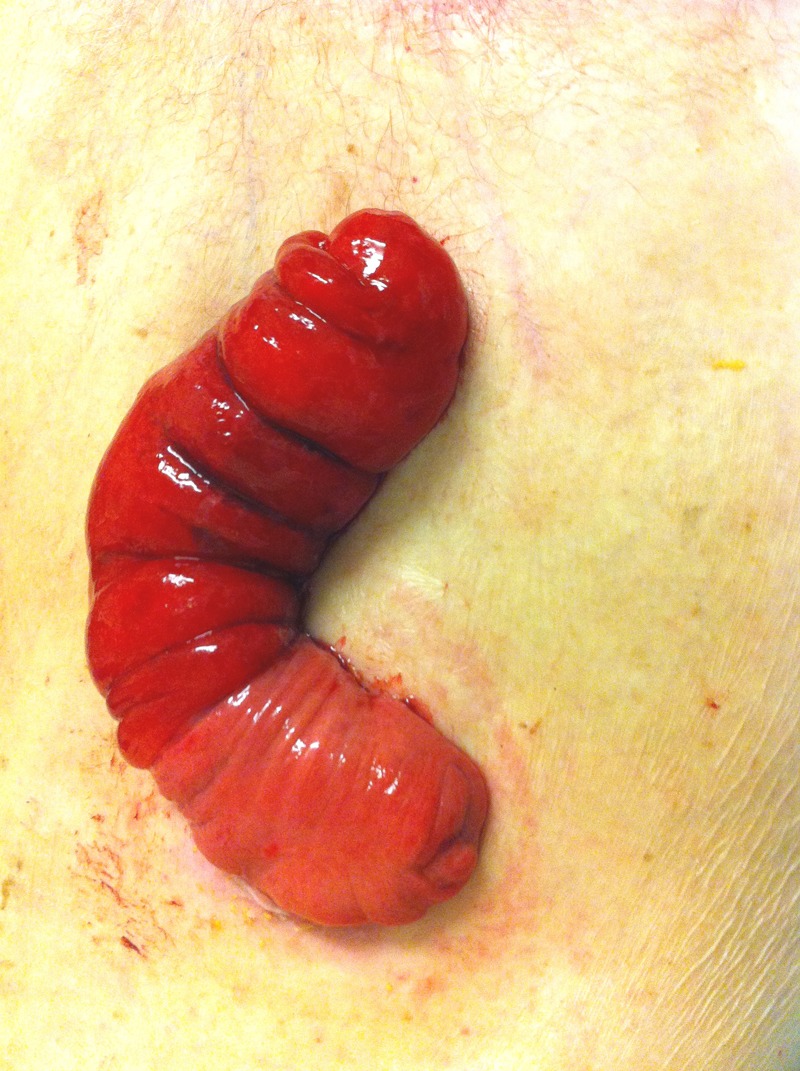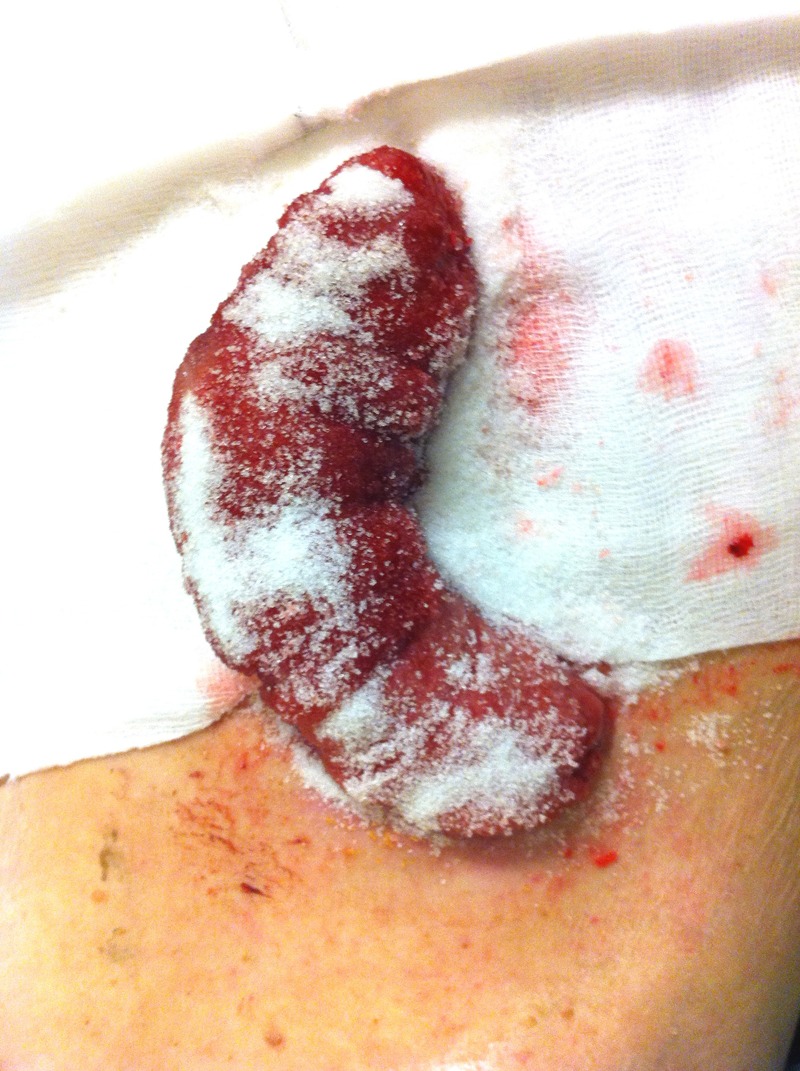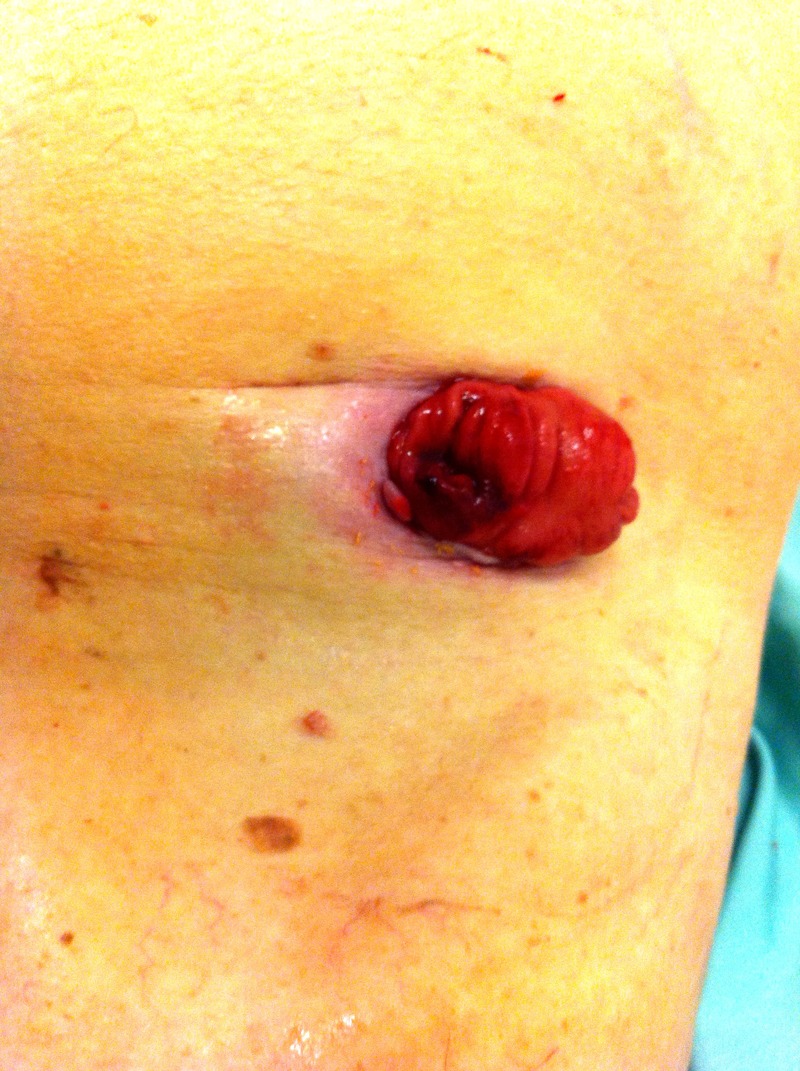Abstract
This case report discusses the successful application of granulated sugar to reduce a prolapsed ileostomy thereby eliminating the need for an emergency surgery.
Background
The incidence of prolapse of stoma is about 2–26%.1 Prolonged exposure of the prolapsed stoma can lead to mucosal ulcerations, bleeding and, rarely, incarceration.2
Manual reduction of a prolapsed stoma, though attempted initially, may be unsuccessful owing to the prolapse becoming oedematous and difficult to manipulate. An irreducible prolapse might necessitate surgical correction which is not without risks and associated morbidities especially in the elderly population. A successful reduction can eliminate the need for emergency surgery and can allow planning for elective surgery at a later stage.
Case presentation
A frail 94-year-old patient who was undergoing palliative radiotherapy for an irresectable rectal tumour presented to us with a prolapse of his defunctioning ileostomy. Upon examination, there was approximately 30 cm of prolapsed small bowel which was very oedematous and congestion of the mucosa was found. He complained of gripping intermittent abdominal pain but denied any vomiting and nausea.
Treatment
Gentle manual reduction of the prolapse was attempted but failed because of gross oedema. Figure 1 shows the prolapsed bowel. One kilogram of granulated table sugar was then applied to the stoma for 15 min (figure 2) and the gentle reduction was attempted again successfully (figure 3).
Figure 1.

Prolapsed ileostomy.
Figure 2.

Granulated sugar on prolapsed ileostomy.
Figure 3.

Ileostomy reduced.
Outcome and follow-up
The stoma was successfully reduced; the patient was kept in hospital overnight for further observation of any potential complications. The patient was safely discharged and allowed to continue radiotherapy. At the time of writing, 9 months following the successful reduction, he has not had a recurrence.
Discussion
The incidence of incarcerated stomas is quite low.3 Literature review has revealed only four reported cases of conservative approaches using sugar for the reduction of a prolapsed incarcerated ileostomy.3–7 There are many more such cases reported for rectal prolapse.2 Application of granulated sugar eliminated the need for emergency surgery, converting an emergency situation into an elective one.3–7
In all the cases reviewed, after initial failed attempts were made to reduce the bowel using manual pressure, granulated sugar was employed as a desiccant to aid bowel prolapse reduction. Granulated sugar is used in an attempt to create a desiccant effect, as well as to create a fluid shift across the oedematous bowel wall. This is dictated by osmotic gradients where a fluid shift is initiated, when low-concentration solvent in the oedematous bowel wall shifts selectively into a region of higher solute concentration created by the granulated sugar placed around the prolapsed bowel. This reduction in bowel calibre owing to fluid shift aids bowel reduction. Two of the reports provide details of follow-up, the first after a month and the other after 6 months. Both document no reoccurrence of the prolapse.
There is no definitive consensus on the management of an irreducible prolapse of a stoma, as the incidence is low. Management varies, depending upon the choice and experience of the surgeon involved. Other conservative measures described in the literature aim to decompress the oedematous bowel using injection of hyaluronidase2 or elastic compression wrapping.7 However, evidence for their efficacy appears to be anecdotal.2
In all cases of prolapse, conservative measures are advantageous, as emergency surgery is associated with postoperative complications especially in the elderly.3
Learning points.
Prolapse of stoma should be managed conservatively in the first instance, attempting to reduce the prolapsed stoma using gentle manual reduction.
Conservative management of incarcerated prolapsed stoma eliminates the need for an emergency surgery.
Although evidence to suggest that the use of granulated sugar is limited, it should be attempted at the earliest before irreversible mucosal ischaemia sets in.
Footnotes
Competing interests: None.
Patient consent: Obtained.
Provenance and peer review: Not commissioned; externally peer reviewed.
References
- 1.Kim JT, Kumar RR. Reoperation for stoma related complications. Clin Colon Rectal Surg 2006;19:207–12 [DOI] [PMC free article] [PubMed] [Google Scholar]
- 2.Seenivasagam T, Gerald H, Ghassan N, et al. Irreducible rectal prolapse: emergency surgical management of eight cases and a review of the literature. Med J Malaysia 2011;66:105–7 [PubMed] [Google Scholar]
- 3.Shapiro R, Chin EH, Steinhagen RM. Reduction of an incarcerated, prolapsed ileostomy with the assistance of sugar as a desiccant. Tech Coloptroctol 2010;14:269–71 [DOI] [PubMed] [Google Scholar]
- 4.Myers JO, Rothenberger DA. Sugar in the reduction of incarcerated prolapsed bowel. Dis Colon Rectum 1991;34:416–18 [DOI] [PubMed] [Google Scholar]
- 5.Brandt ARML, Schouten O. Sugar to reduce a prolapsed ileostomy. N Engl J Med 2011;364:1855. [DOI] [PubMed] [Google Scholar]
- 6.Flingelstone LJ, Wanendeya N, Plamer BV. Osmotic therapy for acute irreducible stoma prolapse. Br J Surg 1997;84:390. [DOI] [PubMed] [Google Scholar]
- 7.Sarpel U, Jacob BP, Steinhagen RS. Reduction of a large incarcerated rectal prolapsed by use of an elastic compression wrap. Dis Colon Rectum 2005;48:1320–2 [DOI] [PubMed] [Google Scholar]


